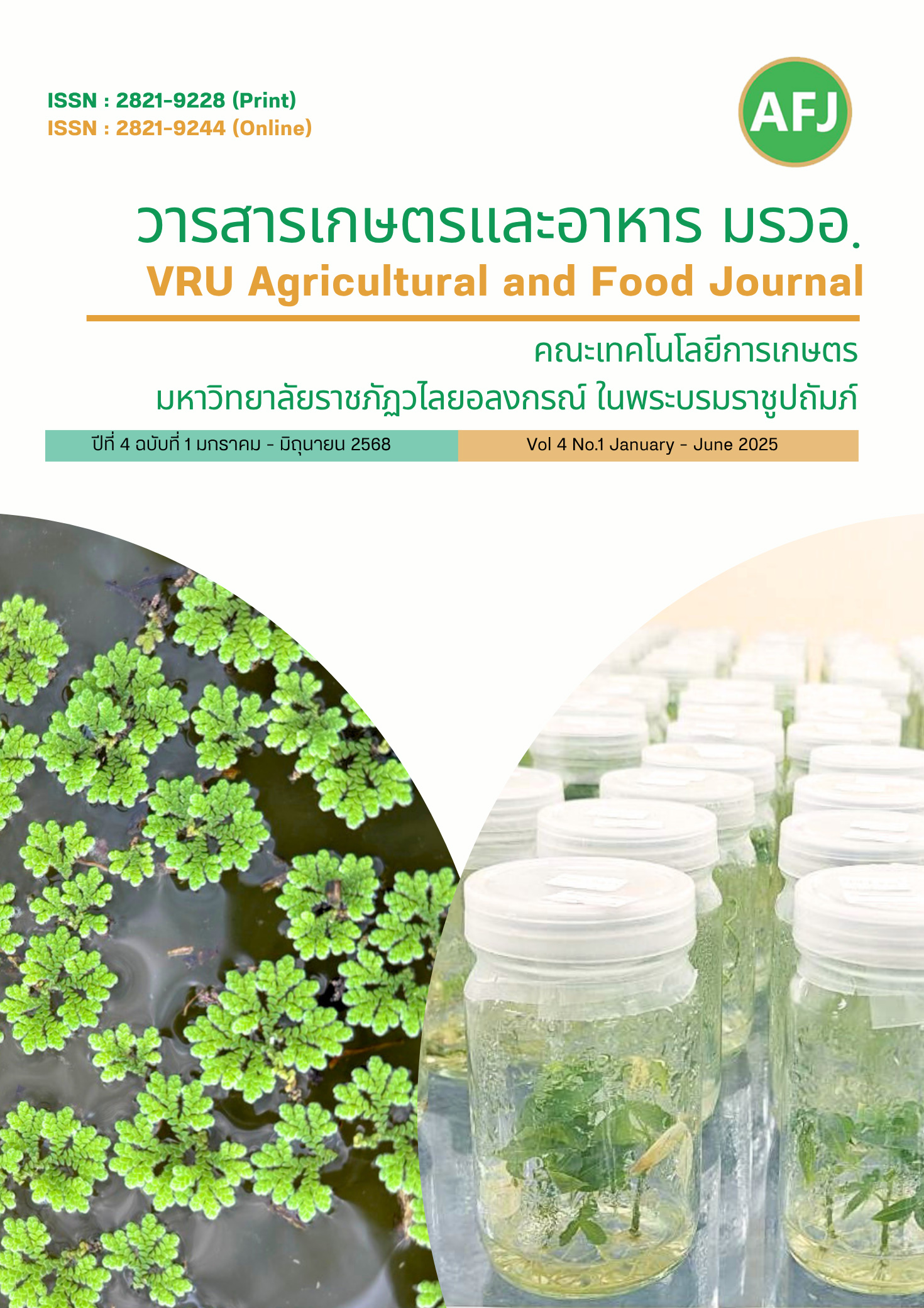การประเมินระยะปลูกที่มีต่อศักยภาพการเจริญเติบโตและผลผลิต ของฝ้ายสายพันธุ์ก้าวหน้า
Main Article Content
บทคัดย่อ
การเจริญเติบโตและการให้ผลผลิตของฝ้ายขึ้นอยู่กับหลายปัจจัย ได้แก่ พันธุ์ สภาพแวดล้อม การจัดการด้านดิน น้ำ ปุ๋ย การควบคุมวัชพืชและศัตรูพืช รวมถึงระยะปลูกหรือจำนวนประชากรต่อพื้นที่ ซึ่งล้วนมีผลต่อปริมาณและคุณภาพของผลผลิต การศึกษานี้มีวัตถุประสงค์เพื่อหาระยะปลูกที่เหมาะสมสำหรับการปลูกฝ้ายสายพันธุ์ก้าวหน้า V1/TF86-8-B-B-B-47B เพื่อให้ได้ผลผลิตสูงและมีคุณภาพดี การทดลองดำเนินการ ณ แปลงทดลองของศูนย์วิจัยพืชไร่นครสวรรค์ ระหว่างเดือนมิถุนายน ถึง ธันวาคม 2566 และวางแผนการทดลองแบบ Randomized Complete Block Design (RCBD) จำนวน 5 ซ้ำ ประกอบด้วยระยะปลูก 4 ระยะ ได้แก่ 1) 1.00 × 0.50 เมตร, 2) 1.25 × 0.50 เมตร, 3) 1.50 × 0.50 เมตร และ 4) 1.75 × 0.50 เมตร ผลการทดลองพบว่า ระยะปลูกไม่มีผลแตกต่างทางสถิติต่อความสูงของต้น จำนวนกิ่งกระโดงและจำนวนกิ่งผลต่อต้น อย่างไรก็ตาม ด้านผลผลิตปุยทั้งเมล็ดพบว่าระยะปลูกแคบสุด 1.00 × 0.50 เมตร ให้ผลผลิตเฉลี่ยสูงสุดที่ 695 กิโลกรัมต่อไร่ รองลงมาคือระยะ 1.25 × 0.50 เมตร ให้ผลผลิตเฉลี่ย 628 กิโลกรัมต่อไร่ สำหรับคุณภาพเส้นใย พบว่าทุกระยะปลูกให้คุณภาพเส้นใยในระดับใกล้เคียงกัน ดังนั้น ระยะปลูกที่เหมาะสมสำหรับการปลูกฝ้ายสายพันธุ์ก้าวหน้า V1/TF86-8-B-B-B-47B คือ 1.00 × 0.50 เมตร หรือคิดเป็นจำนวนประชากร 3,200 ต้นต่อไร่
Article Details

อนุญาตภายใต้เงื่อนไข Creative Commons Attribution-NonCommercial-NoDerivatives 4.0 International License.
บทความนี้ได้รับการเผยแพร่ภายใต้สัญญาอนุญาต Creative Commons Attribution-NonCommercial-NoDerivatives 4.0 International (CC BY-NC-ND 4.0) ซึ่งอนุญาตให้ผู้อื่นสามารถแชร์บทความได้โดยให้เครดิตผู้เขียนและห้ามนำไปใช้เพื่อการค้าหรือดัดแปลง หากต้องการใช้งานซ้ำในลักษณะอื่น ๆ หรือการเผยแพร่ซ้ำ จำเป็นต้องได้รับอนุญาตจากวารสารเอกสารอ้างอิง
Areerak, S., P. Sirisuwanma, S. Rupngam, and P. Siboonyarueang. 2010. Optimal plant population density of promising long-fiber cotton variety. pp. 227–233. In: Research Report 2009, Nakhon Sawan Field Crops Research Center. (in Thai)
Arunvenkatesh, S. and K. Rajendran. 2013. Evaluation of plant density and cotton genotypes (Gossypium hirsutum L.) on cotton yield and fibre quality. Int. J. For. Crop Improv. (4): 1–5.
Bednarz, C.W. and R.L. Nichols. 2005. Phenological and morphological components of cotton crop maturity. Crop Sci, 45, 1497–1503.
Chapman, D. D. 1965. Total Exchange Bases, pp. 902-904. In C. A. Black (ed.). Method of Soil Analysis Part 2: Chemical and Microbiological Properties No. 9. Amer. Soc. Agron. Madison, Wisconsin.
Chongchuaklang, Karita. P. Sebunruang, S. Luanmanee, S. Kongtien and A. Supannarut . 2023. Optimum Population Rate for Cotton Elite lines. In: Annual research report 2021, Volume 2. Nakhon Sawan Field Crops Research Center. Field Crops and Energy Renewable Crops Research Institute Department of Agriculture. (in Thai)
Darawsheh M. K. , E. M. Khah, G. Aivalakis, D. Chachalis and Fatbardh Sallaku. 2009. Cotton row spacing and plant density cropping systemsI. Effects on accumulation and partitioning of dry mass and LAI. J. of Food, Agriculture & Environment, 7(3&4): 258-261.
Fageria, N.K. , V.C. Baligar and C.A. Jones. 1997. growth and mineral Nutrition of field crops. Marcel Dekker Inc. New York. 624 p.
Koudahe, K., A. Y. Sheshukov, J. Aguilar and K. Djaman. 2021. Irrigation-Water Management and Productivity of Cotton: A Review. Sustainability, 13(18): 1-21.
Keswaphithak, P., S. Boonyawirot, C. Tharatthaphan, B. Unkasem, R. Tridet, T.i Sriwanarat, and P. Narttraipob. 1979. Study on fertilizer rates and planting distances of Reba B.T.K.12 cotton under irrigated dry-season conditions. pp. 32–37. In: Dry Season Cotton E×periment Report 1977–1978, Cotton Section, Field Crops Division. (in Thai)
Kongtien, D., S. Luanmanee, P. Sebunruang, K. Tadso, and A. Suphuanarat. 2015. Optimal rate population for Elite lines cotton. pp. 491–498. In: Research Report 2014, Nakhon Sawan Field Crops Research Center. (in Thai)
Marvce, J.N., Beyrouty C.A., and Gbur E.E. 1992. Respond of soybean growth to root and canopy competition. Crop Sci. 32: 797–801.
Office of Agricultural Research and Development. 2020. Technical document: Recommendations for safe pest and insect management based on 2020 research. Department of Agriculture, Bangkok, Thailand. (in Thai)
Peech, M. 1965. Hydrogen-ion Activity, pp. 914-925. In C. A. Black (ed). Method of Soil Analysis Part 2: Chemical and Microbiological Properties No. 9. Amer. Soc. Agron. Madison, Wisconsin.
Walkley, A., and I. A. Black. 1934. An examination of Degtjareff method of determining soil organic matter and a proposed modification of the chromic acid titration method. Soil Sci. 37:29-37.
Wang, R., S. Ji, P. Zhang, Y. Meng, Y. Wang, B. Chen and Z. Zhou. 2016. Drought effects on cotton yield and fiber quality on different fruiting branches. Crop Sci., 56(6): 2661–2670.
Weiner, J. 1993. Competition among plants. Treballs de la SCB 44: 99–109.
Yungmod, U. 1993. Structure and quality of fiber. pp. 184–196. In: Cotton. Technical Paper No. 9. Department of Agriculture, Ministry of Agriculture and Cooperatives, Thailand. (in Thai)
Zaman, I., M. Ali, K. Shahzad, M. Saeed Tahir, A. Matloob, W. Ahmad, S. Alamri, M. R. Khurshid, M. M. Qureshi, A. Wasaya, K. S. Baig, M. H. Siddiqui, S. Fahad and R. Datta. 2021. Effect of plant spacings on growth, physiology, yield fiber quality attributes of cotton genotypes under nitrogen fertilization. Agronomy 1: 1-15.
Zhi, X., Y. Han, Y. L., G. Wang, W. Du, X. and M. Li . 2016. Effects of plant density on cotton yield components and quality. J. of Integrative Agriculture, 15(7), 1469–1479.

